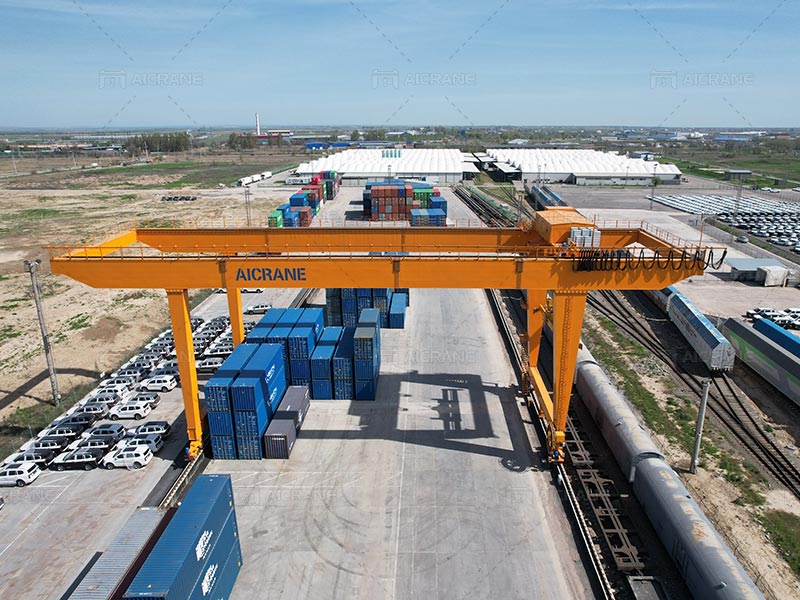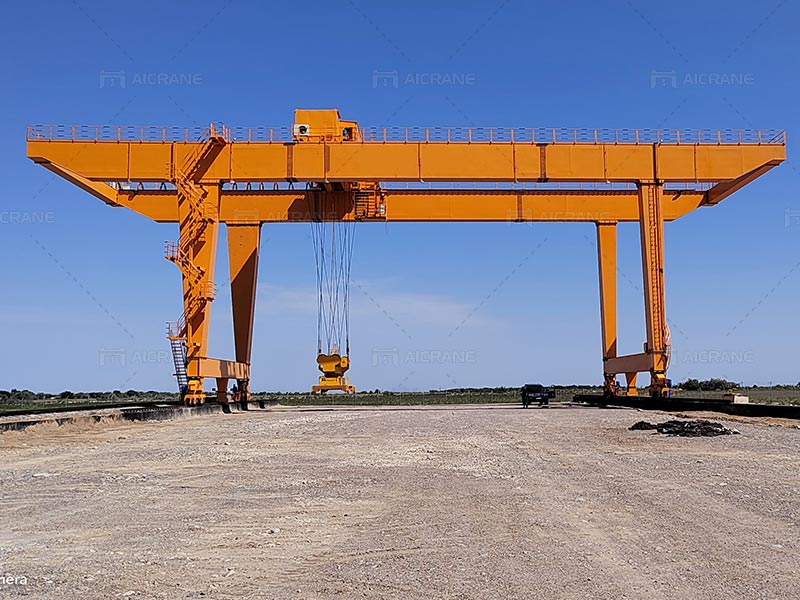Rail-mounted gantry (RMG) cranes are critical assets in container terminals, enabling the efficient handling of shipping containers. These cranes are designed to operate on rail tracks, which provide the stability and precision needed for lifting and moving heavy loads. However, the performance and efficiency of RMG cranes are closely tied to the quality and condition of the rail infrastructure on which they operate. In this article, we explore how rail infrastructure impacts RMG crane performance and what can be done to ensure optimal operation.

The Importance of Rail Infrastructure
Rail infrastructure serves as the foundation for RMG cranes, influencing their overall performance. The primary components of rail infrastructure include the rails themselves, the rail sleepers (also known as ties), the ballast, and the alignment and level of the track. Each of these components plays a crucial role in the stability and smooth operation of the rail mounted crane.
- Rails: The rails must be of high quality and properly maintained to support the weight of the crane and its load. Rails are typically made of steel and must be regularly inspected for signs of wear, deformation, or damage. Any irregularities in the rail surface can lead to increased wear on the crane’s wheels and potentially affect the crane’s accuracy.
- Rail Sleepers: Sleepers provide support for the rails and help distribute the load evenly. They must be installed at the correct spacing and level to ensure that the rails remain properly aligned. Uneven or deteriorated sleepers can lead to misalignment of the rails, causing operational issues for the crane.
- Ballast: Ballast, usually composed of crushed stone, supports the sleepers and helps stabilize the track. It absorbs and distributes the loads imposed by the crane and helps maintain proper track alignment. Over time, ballast can become displaced or compacted, reducing its effectiveness and affecting rail stability.
- Track Alignment and Level: Proper alignment and level of the track are essential for smooth crane operation. Misalignment can lead to uneven load distribution and increased wear on both the crane and the rails. Regular inspections and adjustments are necessary to maintain the correct alignment and level.
Effects of Rail Infrastructure on RMG Crane Performance
The quality of rail infrastructure directly impacts several aspects of RMG container crane performance:
- Load Stability and Safety: A well-maintained rail system ensures that the crane operates smoothly and safely. Irregularities in the rails or misalignment can lead to instability, increasing the risk of accidents or load spills. Ensuring that the rail infrastructure is in good condition helps maintain load stability and operational safety.
- Crane Efficiency and Productivity: Smooth and level rails contribute to the efficient operation of the RMG crane. Irregularities or damage in the rail system can cause the crane to work harder to move loads, leading to decreased efficiency and productivity. Regular maintenance of the rail infrastructure helps optimize crane performance and reduce operational downtime.
- Wear and Tear on Equipment: Poor rail conditions can accelerate wear and tear on the crane’s wheels and other components. For example, uneven rails can cause uneven loading on the crane’s wheels, leading to faster deterioration. Regular inspection and maintenance of the rail infrastructure help extend the lifespan of the crane and reduce maintenance costs.
- Operational Precision: RMG cranes rely on precise movement along the rails to handle containers accurately. Any deviations in the rail alignment can affect the crane’s ability to position loads accurately, leading to potential operational issues. Maintaining proper rail alignment is crucial for ensuring that the crane performs its tasks with high precision.

Best Practices for Maintaining Rail Infrastructure
To ensure optimal RMG crane performance, it is essential to follow best practices for rail infrastructure maintenance:
- Regular Inspections: Conduct regular inspections of the rail system to identify and address any issues promptly. Inspections should include checking for rail wear, alignment, and level, as well as examining sleepers and ballast conditions.
- Routine Maintenance: Implement a routine maintenance schedule for the rail infrastructure, including tasks such as rail grinding, sleeper replacement, and ballast replenishment. Regular maintenance helps prevent issues from developing and ensures that the rail system remains in good condition.
- Track Alignment Adjustments: Monitor and adjust the alignment and level of the track as needed. Use specialized equipment to measure and correct any deviations from the proper alignment to ensure smooth gantry crane operation.
- Prompt Repairs: Address any issues identified during inspections promptly. Repair or replace damaged rails, sleepers, or other components to prevent further deterioration and maintain optimal performance.
- Ballast Management: Regularly inspect and manage the ballast to ensure it remains effective in supporting and stabilizing the track. Replenish or redistribute ballast as needed to maintain proper track support.
- Training and Awareness: Train maintenance personnel on the importance of rail infrastructure and best practices for maintaining it. Ensure that they are aware of the impact of rail conditions on crane performance and are equipped to address any issues effectively.
Conclusion
The performance of rail-mounted gantry (RMG) cranes is intricately linked to the quality and condition of the rail infrastructure on which they operate. Properly maintained rails, sleepers, ballast, and alignment are essential for ensuring the stability, efficiency, and safety of RMG crane operations. By following best practices for rail infrastructure maintenance, terminal operators can optimize crane performance, extend equipment lifespan, and enhance overall productivity. Investing in the upkeep of rail infrastructure not only improves crane performance but also contributes to the overall success and efficiency of container terminal operations. To learn more, visit https://aicraneliftingsolution.com/